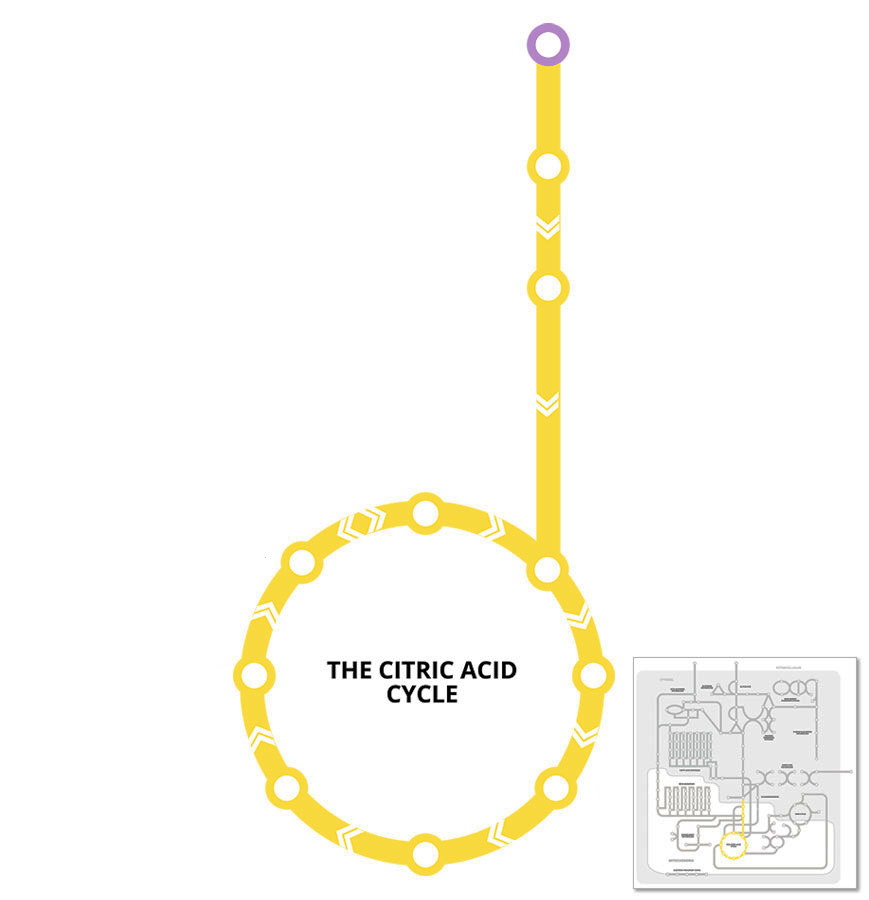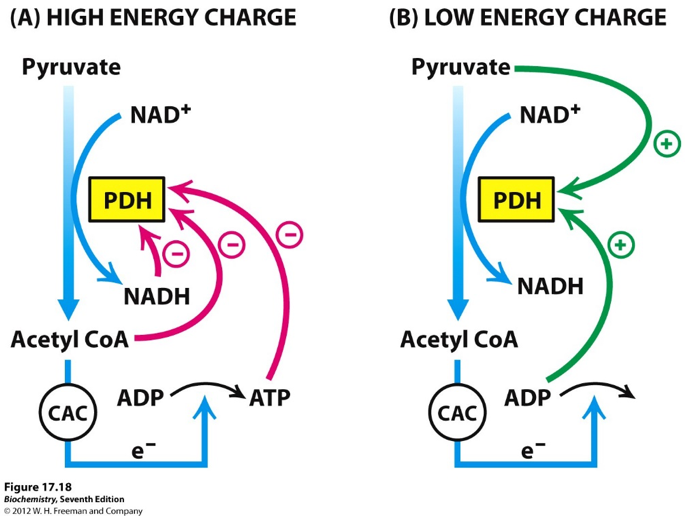
highlight all areas / label key areas

The citric acid cycle is a key energy-producing pathway in cells that connects carbohydrate, fat and protein metabolism, through the breakdown of the common intermediate substrate, acetyl-CoA. It involves a series of enzymatically regulated steps (or reactions) that occur in the mitochondria. The overall reaction is:
1 Acetyl CoA → 1 ATP (as GTP) + 2 CO2 + 3 NADH + 1 FADH2
Regulation of this pathway is complex, but similar to other metabolic pathways like Glycolysis it is responsive to substrate supply and also to the ATP requirements or energetic demands of the cell. The major regulatory mechanism is allosteric modulation of the key regulatory enzymes: Citrate synthase, Succinate dehydrogenase and α-Ketoglutarate dehydrogenase.
Key points:
The final product of Glycolysis, Pyruvate can be transported into the mitochondria for oxidation by citric acid cycle (see The Citric Acid Cycle pathway) or converted to Lactate (in the cytosol).
Within the mitochondria, pyruvate can undergo conversion to acetyl CoA and enter the citric acid cycle. The mitochondrial pyruvate dehydrogenase (PDH) complex catalyses this reaction.
Pyruvate + CoA + NAD+ → Acetyl CoA + CO2 + NADH
Key points:
Activated by:
Inhibited by:

Acetyl-CoA , or Acetyl coenzyme A, is the primary substrate for the Citric acid cycle. Acetyl CoA is generated by the breakdown of carbohydrates through glycolysis (see Glycolysis pathway), by the breakdown of fatty acids through β-oxidation (see Beta-Oxidation pathway) and via amino acid (protein) metabolism.
Citrate synthase is the enzyme that regulates the first committed step in the Citric acid cycle:
Acetyl-CoA + Oxaloacetate → Citrate + CoA
Key points:
Activated by:
Inhibited by:
Elevated levels of this citric acid cycle intermediate, Citrate can feedback to inhibit the key glycolytic enzyme (Phosphofructokinase, see Glycolysis pathway), as well as Pyruvate dehydrogenase, and key enzymes of the citric acid cycle including Citrate synthase, and Succinate dehydrogenase.
This level of regulation ensures that energy substrate supply is closely matched to the ATP requirements or energetic demands of the cell.
Citrate is also exported from the citric acid cycle and mitochondria, into the cytosol, where it is converted back to acetyl-CoA for the synthesis of fatty acids (see Fatty Acid Synthesis pathway) and cell signalling functions as a substrate for protein acetylation.
This reaction is one of the irreversible reactions in the citric acid cycle and is therefore carefully regulated:
Isocitrate + NAD+ → α-ketoglutarate + NADH + CO2
Key points:
This enzyme (also known as 2-oxoglutarate dehydrogenase) is the most important enzyme in the citric acid cycle as it controls this rate limiting reaction:
α-Ketoglutarate + CoA + NAD+ → Succinyl CoA + NADH + CO2
Key points:
This enzyme catalyses the conversion of Succinyl CoA to Succinate, which also facilitates the formation of energy (ATP) in the form of GTP.
Succinyl CoA → Succinate + CoA + ATP (as GTP)
This enzyme plays an important role in regulating reactions in both the citric acid cycle and the electron transport chain.
Succinate + FAD → Fumarate + FADH2
Key points:
The mitochondria form of this enzyme controls the reversible reaction between malate and oxaloacetate
Malate + NAD+ ↔ Oxaloacetate + NADH + H+
For the citric acid cycle to operate at a high rate (when the energy demand of the cell is high) then there must be sufficient oxaloacetate produced to accept acetyl groups from acetyl CoA in the first reaction of the citric acid cycle.
Key points: